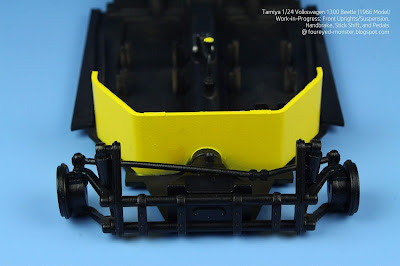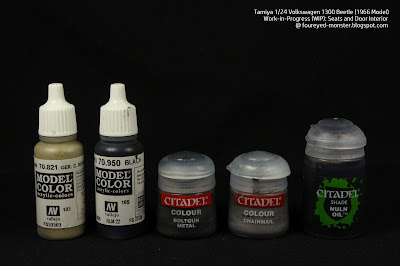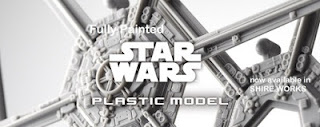This extended stay-at-home period has allowed me to sustain a level of focus on my scale modeling and miniature painting activities that I would otherwise never been able to achieve prior to the ongoing global pandemic. It has given me precious opportunity to clear my backlog of stalled projects. Not all of it though, as some projects retain a higher
on-the-shelf-gathering-dust inertia than others. One project with new life breathed into it is the
Tamiya 1/24 scale Volkswagen 1300 Beetle (1966 Model) which acts as a proxy for the
Transformer Autobot Bumblebee in vehicle configuration.
 |
| Tamiya VW Beetle Work-in-Progress: Front Uprights/Suspension, Handbrake, Pedals & Shift Stick |
So far I've been following the recommended order of assembly which in this case involved Steps Five through Seven (
see instructions below). In this series of steps, the Front Uprights, Handbrake, Front Suspension, Stick Shift and Pedals (
see above) were put together and painted. In terms of difficulty, the only real one I faced was the fragility of the Stick Shift. I went through hell twice with this tiniest of parts, which I'll elaborate on later in the post. Everything else was quite straightforward.
 |
| Steps Five through Seven of the Tamiya 1/24 scale Volkswagen 1300 Beetle (1966 Model) |
 |
| Front Uprights/Suspension, Handbrake, Stick Shift and Pedals prior to being fixed to the WIP Chassis |
 |
| Front Uprights/Suspension, Handbrake, Stick Shift and Pedals after being fixed to the WIP Chassis |
Just from looking at the state of the Front Uprights and Front Suspensions as they are right now, I have an inclination to weather them extensively in dirt and dark rust colors. And in a normal vehicle I would've already done so. However, this Volkswagen Beetle is supposed to be the vehicular form of
Bumblebee. As such one could logically conclude that his insides won't be rusted, unless for disguise purposes. At the end of the day, it's all make believe so for now I'll leave it in its all-black color scheme. The blacks are differentiated only by glossiness and semi-glossiness of its surfaces.
 |
| Volkswagen 1300 Beetle (1966 Model) Front Uprights/Suspension (isometric view, left side) |
 |
| Volkswagen 1300 Beetle (1966 Model) Front Uprights/Suspension (isometric view, front) |
 |
| Volkswagen 1300 Beetle (1966 Model) Front Uprights/Suspension (isometric view, right side) |
Apart form the Front Uprights/Suspension sub-assembly, this stage of the assembly process also required a few key items of the interior to be installed. This as I mentioned earlier comprised the Stick Shift, Handbrake and Clutch/Brake/Accelerator Pedals (
see below).
 |
| Volkswagen Beetle's interior will soon receive its seats as well as the dashboard while ... |
 |
| ... its engine (lower left corner) can only be called complete when its Air Cleaner System (not shown) is fixed |
 |
| First closeup view of the Handbrake, Stick Shift and Pedals in the currently bare interior of the Beetle |
One issue, partly self-inflicted through clumsiness and partly due to a design induced flimsiness, had caused me a bit of a hiccup during assembly. To my horror, the Stick Shift had snapped into two even though I was consciously aware of its weak design
and was being extra careful. Worse still, it broke not once but twice. Putting such a tiny part back together again would've been impossible if it wasn't for the
Mr.Hobby Mr.Cement S low viscosity plastic glue. Luckily for me the Stick Shift was a plastic part. If it had been a resin or photo-etched part, I couldn't have used that life saving glue on it.
 |
| Use of a paperclip and a five sen coin as scale comparison for the Tamiya Beetle |
While the Front Uprights/Suspension has been left in its pure all-black state, the case was marginally different for the Handbrake, Stick Shift and Pedals. These were painted, then fixed onto the interior before being weathered with Dark Rust and Dirt pastels of the
Tamiya Weathering Master kit.
 |
| At this early stage, the Beetle interior is still extremely bare safe for the Pedals, Stick Shift and Handbrake |
 |
| Volkswagen 1300 Beetle with Clutch/Brake/Accelerator Pedals, Stick Shift and Handbrake attached |
 |
| Volkswagen 1300 Beetle's Clutch, Brake and Accelerator Pedals (closeup view) |
In the last two photos of this blog (
the one above and below this paragraph), I used my DSLR camera with a dedicated macro lens to allow me to capture an extremely closeup view of the Clutch/Brake/Accelerator Pedals, Handbrake and Stick Shift. It's only with these macro shots that the texture of the Pedals, for instance, become visible to the naked eye. Equally pleasing was the fact that my Stick Shift repair job seems to be largely invisible unless you look very carefully. Unfortunately, the extreme closeups also laid bare my incompetent job during the prep stage. In these same photos you can easily spot the injector pin marks that I forgot to sand away before priming and painting.
 |
| Volkswagen 1300 Beetle's Stick Shift and Handbrake (closeup view) |
Going forward things will hopefully be more aesthetically pleasing for my Bumblebee Beetle project. Next on the to-do-list are the more interesting bits of the Beetle's interior such as the front/rear seats, doors, dashboard, steering, etc. Lots to do, lots to look forward to. And with that I leave you with a quote from the Bumblebee movie's main protagonist Charlie Watson ...
"People can be terrible about things they don't understand." It's my one-fingered salute to online social media idiots who've spread life-threatening misinformation during the pandemic. As always, stay safe dear readers.
























.jpg)






































